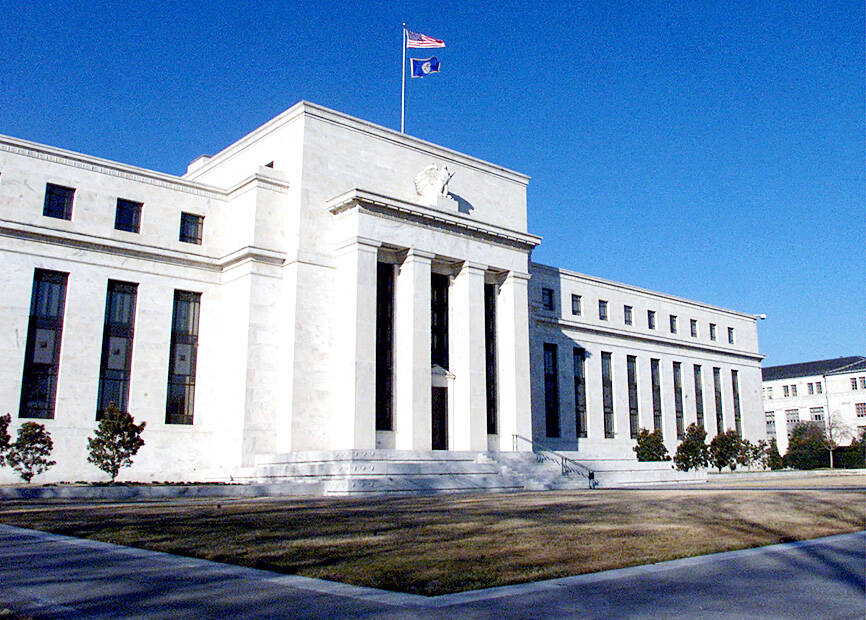After pausing last month, the US Federal Reserve is widely expected to hike interest rates again on Wednesday, adopting its most restrictive monetary stance for 22 years despite recent signs of slowing inflation.
After 10 consecutive hikes in just over a year, the Fed halted its aggressive campaign of monetary tightening last month to give policymakers more time to assess the health of the US economy, and the impact of recent banking stresses on lending conditions.
In the weeks since, positive upgrades to economic growth and cooler inflation data have reinforced the likelihood that the Fed’s rate-setting Federal Open Market Committee (FOMC) will vote for a quarter-percentage-point hike on July 25 and 26.

Photo: Reuters
This would raise the federal funds rate to a range between 5.25 and 5.5 percent — its highest level since 2001.
“If I had to bet, I would bet they would raise the Fed funds rate 25 basis points at the next meeting,” Peterson Institute for International Economics senior fellow Joseph Gagnon said.
“The cooling of the economy is only happening slowly,” Bank of America Corp chief US economist Michael Gapen wrote in a recent investors’ note.
“We think most committee members believe further rebalancing of supply and demand is needed to ensure disinflation will continue,” he added, explaining why he expects another hike on Wednesday.
Futures traders now assign a probability of more than 99 percent that the Fed will hike its base rate by 25 basis points at its next meeting, according to CME Group Inc.
At its meeting last month, Fed officials indicated that they expect two additional quarter-percentage-point hikes would be needed this year to tackle inflation.
With the first interest rate hike widely expected on Wednesday, analysts have turned their attention to what the Fed does next. Some economists predict another rate hike as soon as the Fed’s next rate meeting in September, while others think it could hold rates steady once more.
“My feeling is that, although they’re going to move slowly, 25 basis points a meeting or even every other meeting, I don’t think they’re going to stop,” Gagnon said.
Due to the uncertainty about September, Fed Chair Jerome Powell’s press conference after the rate decision will be closely scrutinized for hints at what the US central bank might do next.
“In the press conference, we look for Chair Powell to provide more clarity on what markers the Committee would need to see to be comfortable moving into an extended hold,” Morgan Stanley economists wrote in a recent note to clients.
While the European Central Bank is also expected to raise interest rates by 25 basis points in the coming week, the greater focus would be on signaling from policy makers on whether more hikes are likely — or if they plan an extended pause.
The Bank of Japan remains the outlier, with more than 80 percent of analysts polled expecting Governor Kazuo Ueda to continue pumping support into the world’s No. 3 economy even as inflation remains above their 2 percent target.
Additional reporting by Bloomberg

PROTECTION: The investigation, which takes aim at exporters such as Canada, Germany and Brazil, came days after Trump unveiled tariff hikes on steel and aluminum products US President Donald Trump on Saturday ordered a probe into potential tariffs on lumber imports — a move threatening to stoke trade tensions — while also pushing for a domestic supply boost. Trump signed an executive order instructing US Secretary of Commerce Howard Lutnick to begin an investigation “to determine the effects on the national security of imports of timber, lumber and their derivative products.” The study might result in new tariffs being imposed, which would pile on top of existing levies. The investigation takes aim at exporters like Canada, Germany and Brazil, with White House officials earlier accusing these economies of

Taiwan Semiconductor Manufacturing Co (TSMC, 台積電) would not produce its most advanced technologies in the US next year, Minister of Economic Affairs J.W. Kuo (郭智輝) said yesterday. Kuo made the comment during an appearance at the legislature, hours after the chipmaker announced that it would invest an additional US$100 billion to expand its manufacturing operations in the US. Asked by Taiwan People’s Party Legislator-at-large Chang Chi-kai (張啟楷) if TSMC would allow its most advanced technologies, the yet-to-be-released 2-nanometer and 1.6-nanometer processes, to go to the US in the near term, Kuo denied it. TSMC recently opened its first US factory, which produces 4-nanometer

Teleperformance SE, the largest call-center operator in the world, is rolling out an artificial intelligence (AI) system that softens English-speaking Indian workers’ accents in real time in a move the company claims would make them more understandable. The technology, called accent translation, coupled with background noise cancelation, is being deployed in call centers in India, where workers provide customer support to some of Teleperformance’s international clients. The company provides outsourced customer support and content moderation to global companies including Apple Inc, ByteDance Ltd’s (字節跳動) TikTok and Samsung Electronics Co Ltd. “When you have an Indian agent on the line, sometimes it’s hard

‘SACRED MOUNTAIN’: The chipmaker can form joint ventures abroad, except in China, but like other firms, it needs government approval for large investments Taiwan Semiconductor Manufacturing Co (TSMC, 台積電) needs government permission for any overseas joint ventures (JVs), but there are no restrictions on making the most advanced chips overseas other than for China, Minister of Economic Affairs J.W. Kuo (郭智輝) said yesterday. US media have said that TSMC, the world’s largest contract chipmaker and a major supplier to companies such as Apple Inc and Nvidia Corp, has been in talks for a stake in Intel Corp. Neither company has confirmed the talks, but US President Donald Trump has accused Taiwan of taking away the US’ semiconductor business and said he wants the industry back